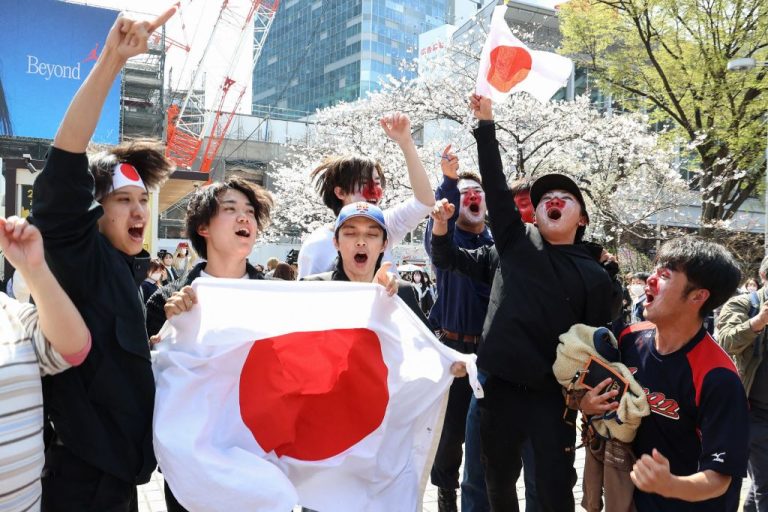Japanese citizens are taking classes to learn how to smile during social interactions again after three years of masking during the coronavirus pandemic, according to local media reports.
Trainer Keiko Kawano told Japan’s Asahi Shimbun newspaper in a May 8 article, “With mask wearing having become the norm, people have had fewer opportunities to smile, and more and more people have developed a complex about it.”
Accompanying the article is a photograph of elderly Japanese people sitting in a classroom, holding a compact mirror and smiling in front of it.
MORE ON MASK MANDATES
- Excess CO2 Exposure From Mask Mandates Behind Spike in Stillbirths, Posits Peer Reviewed Study
- Dallas Airport Installs Panopticon Facial Recognition Robots to Enforce Mask Mandates
- Speech Therapist Notices a 364 Percent Soar in Child Patients After Mask Mandates
One participant interviewed told Shimbun, “I want to apply what I learned today at volunteer activities and other gatherings,” adding that she understood that, “Smiles are essential for maskless communication.”
Entrenched habit
Technically, masking as a government recommendation ended in March, reported The Japan Times, but with some caveats such as bus operators being allowed to “ask” riders and drivers and many retail outlets relaxing mask requirements for customers but maintaining them for employees.
Success
You are now signed up for our newsletter
Success
Check your email to complete sign up
But entrenched habits die hard. An Associated Press release at the time noted that the majority of Tokyo commuters and crowds attending the round robin stage of the World Baseball Classic international championship were seen remaining masked.
Yet a social change nonetheless manifested on May 8 when a February decision by the federal government to reduce COVID-19 to the same level as the seasonal flu came into play.
A second article by The Japan Times on the February decision notes, “There has never been a mask mandate in Japan, but mask-wearing has become a daily custom since the outbreak began.”
Interference in human-to-human non-verbal communication by masks has been well established in Japan since the pandemic began. In June 2020, a Japanese television station ran a segment utilizing a model instructing viewers to lift their lower eyelids to communicate smiling in place of being able to show the lower half of their face.
The Guardian reported in coverage of the topic on May 16 that Kawano’s company claims to have seen a 4.5 fold increase in takers of her smile classes immediately following the February announcement.
An article by The New York Times added that since the pandemic began, she has been contracted by firms as big as IBM Japan to conduct “a smiling-training session for company employees and their families.”
A spokesperson for IBM Japan told the paper that the lessons were “received well.”
Trying to smile
Kawano told the Times that after the February announcement on the relaxation of social measures was announced, “People started realizing that they hadn’t used their cheek or mouth muscles very much.”
“And you can’t just suddenly start using these muscles. You need to work on them,” the trainer said.
The outlet paraphrased a professor at Tel Aviv University specializing in facial expressions as somewhat dissenting on the basis that she “was not aware of any academic studies documenting the effects of long-term masking on facial muscles.”
But the professor did concede that a use for classes and training may arise because “a possible problem with a practiced or faked smile is that it may be identified as such by other people.”
A third article by The Japan Times from March elucidated Kawano’s training methods, noting that her students were mostly female.
“After standing and limbering up with some tension-relieving stretches, they sat back down and were directed to lift their hand-held mirrors to eye-level,” the article stated.
It added, “They gazed into their reflections as they listened to a female instructor at the front, who asked them to flex various parts of their faces in order to get the warmest and brightest expression of happiness.”
NYT noted that Kawano sells one-day certified training courses teaching people who want to teach smiling classes for 80,000 yen ($650~ USD).
The Japan Times stated that Kiwano has been selling the certification since 2017 and has produced 700 instructors.
One 61-year-old woman who paid for the course told The New York Times that “sometimes, you need to show a nice, professional smile, and people don’t know much about that.”
Kawano, meanwhile, told the Asahi that “smiling not only makes a good impression on others and facilitates communication but also has the effect of making yourself feel more positive.”
This principle was confirmed by The Times, who quoted a psychologist at Japan’s Chuo University as stating, “Intentional muscle moves will send signals to your brain and generate positive feelings, even if you are not feeling happy.”
Some science confirms the idea. A 2010 study placed participants in “high power” and “low power” poses — such as sitting like an archetypical businessman or standing like a superhero — versus standing and giving themselves a hug or sitting with hands together in a chair — to see if the actions corresponded to an increase or decrease in the hormones testosterone (power) and cortisol (stress).
A 2011 article by Psychology Today states the study found conclusively that “participants who assumed high-power poses had their testosterone levels increase relative to their baseline, while participants who assumed low-power poses had their testosterone levels drop. The reverse was true of cortisol levels.”
‘Fear and shyness’
Nonetheless, The Guardian noted that a significant percentage of Japanese employees currently intend to wear masks regardless of changing social norms.
A survey by “a research group specialising in careers” found that “27.8% of company employees in their 20s to 50s said they would continue to wear masks ‘unconditionally’,” the outlet reported.
Slightly more than two-thirds of respondents said “they would decide on whether or not to cover up depending on the situation” while only 5.5 percent of respondents said they were happy to be free of masking.
A 74-year-old woman who took the smiling class told The Japan Times, “I think there’s some fear and shyness with the movement to take masks off.”
“Plus, people have been wearing masks for so long that they might have even forgotten what their friends’ faces looked like, and sometimes when you see someone and they take their masks off after a while, the bottom-half is so unexpected,” she added.


















